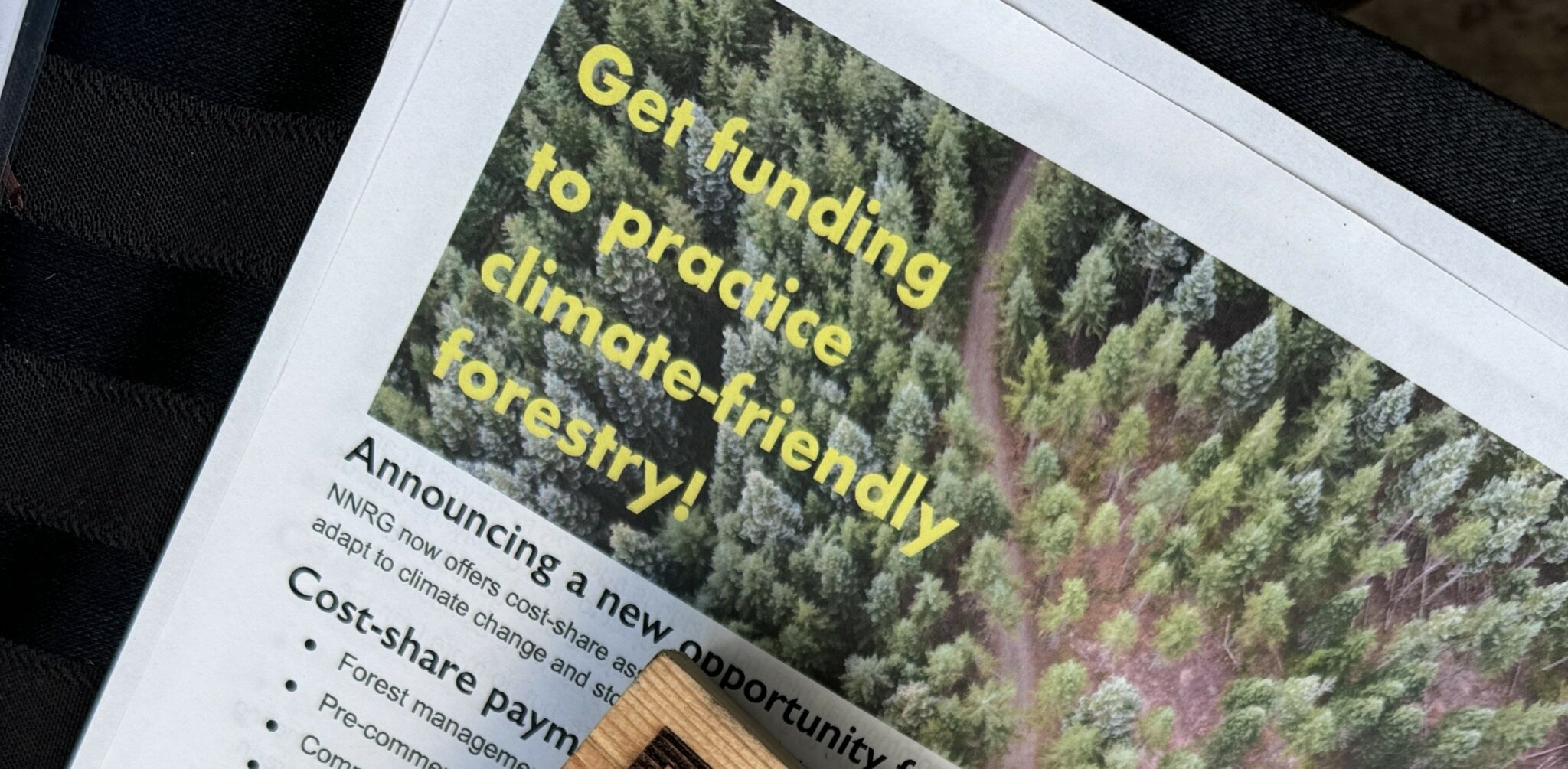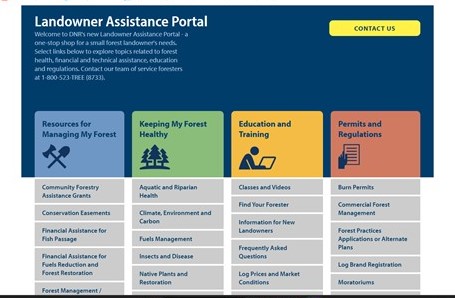Maximizing Your Forest’s Potential – A Guide To Financial Assistance for Small Forest Owners

Managing a forest can be both rewarding and challenging, particularly for small private forest owners. Various federal, state, and county cost-share programs are available to support sustainable forest management activities. These programs are designed to offset the costs of management activities and typically work as a reimbursement model – meaning that you get paid the cost-share after the work is completed to spec. In addition, they provide technical guidance and other resources to help you enhance your forest’s health, productivity, and ecological value. You may enroll in multiple programs, but you cannot use more than one program for the same practice on the same acreage.
As small forest owners, your management activities contribute to the broader health of ecosystems and provide essential services such as clean air and water. Utilizing these programs has benefits beyond just your acreage.
Why Participate in Cost-Share Programs?
- Financial Assistance – Offset the costs of forest management activities, making it more affordable to implement best practices.
- Technical Support – Gain access to expert advice and guidance from forestry professionals.
- Sustainable Management – Improve your forest’s health, productivity, and ecological value.
- Long-Term Benefits – Enhance your forest’s resilience to pests, diseases, and climate change.
- Community and Environmental Impact – Contribute to broader conservation goals and community well-being.
Here’s a guide to how to take advantage of these opportunities.
Federal Cost-Share Programs
Enrolling your forest with the Farm Service Agency (FSA) will qualify you for several federal cost-share programs, including NNRG’s new stewardship funding through the US Department of Agriculture (USDA). The application may seem daunting at first, but the FSA staff know it well and are there to guide you through it. These programs are standard for agriculture crops but also include forest management.
To get started, contact your local FSA office (WA and OR) and schedule a time to enroll your forest. We recommend going in person and getting to know the FSA agent who will support you through the process. Let them know you’d like to complete the entire packet so you may apply to the various federal cost-share programs. They will assign a unique farm number for your property and identify field and tract numbers that identify acreage used for crop production, in your case, forest products. You don’t need to be the property owner to apply, but you do need to be an operator. They will look to see if the lease/operator agreement exceeds the timespan of funded practices. Once enrolled, you will create a farmers.gov account that provides easy access to the documents needed to apply for funding.
This process gets you started on applying for various federal programs, including NNRG’s Stewardship Funding and other Climate Smart Commodities (CSC) programs. It also includes the Natural Resources Conservation Service (NRCS) programs, such as the Environmental Quality Incentives Program (EQIP) and the Conservation Stewardship Program (CSP).
Participation in these programs can take time to get from a place of interest to implementing practices. Processes are in place to ensure best management practices and compliance with environmental standards. It takes some effort upfront, but the long-term benefits are worth it. For example, a forest management plan may happen faster than an on-the-ground practice that requires an environmental review. Most programs can take 12-18 months from enrollment to approval for funding, so plan ahead and consider it a long-term investment.
With funding from the USDA’s Climate-Smart Commodities program, NNRG can now directly offer cost-share assistance to landowners in western Washington. NNRG provides this funding as part of a coalition that has launched an initiative promoting forest health, climate resilience, and carbon storage – and connecting those landowners with green builders who want climate-smart wood.
How to get started
- Enroll with the FSA if you aren’t already
- Fill out the NNRG interest form
- Talk with an NNRG forester (site visit possible) to identify practices needed.
- Fill out the NNRG application form
- On the ground, projects require USDA environmental review
- Reimbursement upon completion
Important Information:
- Funded practices focus on increasing climate resilience and are less broad than the NRCS EQIP practice list. A list of practices is available here.
- The funding levels for management planning are slightly higher than EQIP to account for the extra costs of planning to accommodate and respond to climate change.
- NNRG can also support some practices, such as carbon modeling, forest management plan updates for climate adaptation, and commercial thinning of low-value stands that are not fundable through other programs.
- Applications are reviewed year-round and aren’t limited by funding cycles.
- NNRG supplies funding and can provide forest planning and management services, limiting the need to find a contractor.
- All practices must be paid for by April of 2028
Environmental Quality Incentives Program (EQIP)
Administered by the Natural Resources Conservation Service (NRCS), EQIP offers financial and technical assistance for new conservation practices for non-industrial forest owners. The program aims to conserve ground and surface water, improve air quality and sequester carbon, increase soil health, reduce soil erosion, improve and create wildlife habitat, and mitigate drought and weather volatility. NRCS offers technical assistance at no cost.
How to get started:
- Enroll with the FSA if you aren’t already
- Contact your local NRCS office to discuss your forest management goals and eligibility. They are often in the same office as your FSA contact.
- Apply through the NRCS office.
- Develop a conservation plan with NRCS assistance, outlining your proposed management activities.
Important Information:
- Flexible contract duration ranging from 1 to 10 years.
- Applications for NRCS conservation programs are accepted continuously; however, customers should apply by state-specific ranking dates to be considered for the current funding cycle.
- Washington for FY25 is October 22, 2024
- Oregon hasn’t been announced, but watch this website.
- To qualify, you must complete your FSA enrollment before the ranking date.
- NRCS provides funding, but you must find a contractor to complete the work.
- There is no minimum acreage requirement.
Conservation Stewardship Program
The Natural Resources Conservation Service (NRCS) Conservation Stewardship Program (CSP) is a voluntary program encouraging agricultural producers and forest landowners to maintain and improve their conservation activities while adopting new ones. Participants develop a plan that outlines their conservation goals and practices and receive annual payments based on the level of conservation performance. It includes a wide range of practices such as soil health improvement, water quality enhancement, habitat creation for wildlife, pest management, and energy conservation.
How to get started:
- Enroll with the FSA if you haven’t already done so.
- Contact your local NRCS office to discuss your forest management goals and eligibility. They are often in the same office as your FSA contact.
- Apply through the NRCS office.
- Develop a conservation plan with NRCS assistance, outlining your proposed management activities.
Important Information:
- Contracts are for five years.
- An applicant must implement at least one “enhancement”, which is a practice that goes above and beyond their current level of stewardship.
- To qualify, you must complete your FSA enrollment before the ranking date.
- Washington for FY25 is January 17, 2025
- Oregon hasn’t been announced, but watch this website.
- The evaluation and approval process can take several months.
- NRCS provides funding, but you must find a contractor to complete the work.
State cost-share Programs
Washington State Department of Natural Resources (DNR) – Small Forest Landowners
The Department of Natural Resources (DNR) provides financial assistance for wildfire resilience and forest health and to write forest management plans. The program was initially focused on Eastern WA but is now available in Western WA. Assistance is available to private forest owners who own up to 5,000 acres. The DNR also offers financial support to create fish passage and maintain riparian habitat. In partnership with Washington State University, there is a variety of free technical assistance for forest owners with 5+ acres of land.
How to get started:
- Contact your DNR service forester to schedule an onsite consultation, which can take up to 2 hours.
- During the visit, they can provide technical assistance regarding your projects and discuss which financial assistance programs you qualify for.
Important Information:
- Applications are received and reviewed year-round.
- DNR provides funding to offset the costs, but you must find a contractor to complete the work if you can’t do it yourself.
- Visit the Landowner Assistance Portal for information on all the offerings.
Oregon Department of Forestry (ODF) – Forest Stewardship Program
The Forest Stewardship Program, through the U.S. Forest Service, partners with state agencies to assist landowners in developing forest management plans. A professional natural resource consultant must write plans; funding provides up to 75% cost-share reimbursement. Plans are good for ten years unless updated before then.
How to get started:
- Find a consulting forester who can assist you with developing a forest management plan.
- Complete the ODF cost-share application.
Important information:
- ODF must review, approve, and develop plans according to the Oregon Forest Management Plan tools and guidance.
- Cost-share must be pre-approved by ODF before the creation of the plan.
- The plans do not include a timber cruise or appraisal.
Conservation Districts
Conservation districts in Washington and Oregon play a pivotal role in promoting sustainable land management practices. By providing cost-share opportunities, technical assistance, and educational resources, they help landowners undertake essential conservation activities such as reforestation, erosion control, and habitat restoration. These initiatives not only enhance the region’s environmental well-being but also strengthen local ecosystems’ resilience against climate change’s impacts. Many conservation districts connect you to state and federal cost-share programs, but we have highlighted some below that offer their own financial assistance. Regardless of the specific programs, all districts provide valuable educational and technical assistance. To find the conservation district for your county, visit these links for Washington and Oregon.
King Conservation District – offers a Small Lot Forest Stewardship program to support and encourage private landowners with fewer than five acres of woods in unincorporated King County to implement sustainable stewardship-focused active management practices.
Pierce and Mason County Conservation District – have access to a shared forester based out of the Mason Conservation District. The forester can assist small 5-20-acre forest landowners interested in improving forest health and managing for a variety of needs, including wildlife habitat, wildfire prevention, and water quality. Pierce County partners with Washington Conservation Action to offer cost-share funding.
San Juan Islands Conservation District – assist forest landowners in improving forest health and wildfire preparedness in San Juan County. Two programs are currently available to help implement practices that include small-diameter (<8″dbh) thinning, woody residue treatment, Home Ignition Zone treatments, and shaded fuel breaks.
Tualatin Soil and Water Conservation District, OR – the streamside planting program in the Tualatin River watershed covers the cost of project planning, labor and materials.
Navigating the array of cost-share programs available for small private forest owners can be daunting, but the benefits far outweigh the effort. By taking advantage of federal, state, and county programs and initiatives like the NNRG’s stewardship funding, you can achieve sustainable forest management while receiving financial and technical support. Contact your local NRCS office, state forestry agency, or county extension office to explore available opportunities. Your forest, future generations, and the environment will thank you.


Leave a Reply